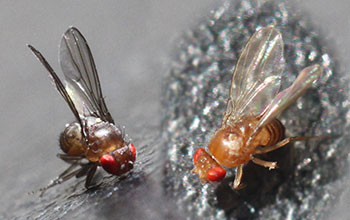Multimedia Gallery
Fruit flies produce offspring with greater genetic variability (Image 1)
In a recent study, researchers discovered that when infected by parasites or bacteria, the offspring of ebony rough (left) and wild type (right) fruit flies produce a more genetically diverse progeny.
The study, which was conducted by researchers at North Carolina (NC) State University and Reed College, shows when fruit flies are attacked by parasites or bacteria, they respond by producing offspring with greater genetic variability. This extra genetic variability may give the offspring an increased chance of survival when faced with the same pathogens. These findings demonstrate that parents may purposefully alter the genotypes of their offspring.
[Research supported in part by a grant from the National Science Foundation (grant IOS 12-57469).]
To learn more, see the NC State news story When Fruit Flies Get Sick, Their Offspring Become More Diverse. (Date image taken: August 2015; date originally posted to NSF Multimedia Gallery: Nov. 3, 2015) [Image 1 of 2 related images. See Image 2.]
Credit: Dahlia Nielsen, NC State University
Images and other media in the National Science Foundation Multimedia Gallery are available for use in print and electronic material by NSF employees, members of the media, university staff, teachers and the general public. All media in the gallery are intended for personal, educational and nonprofit/non-commercial use only.
Images credited to the National Science Foundation, a federal agency, are in the public domain. The images were created by employees of the United States Government as part of their official duties or prepared by contractors as "works for hire" for NSF. You may freely use NSF-credited images and, at your discretion, credit NSF with a "Courtesy: National Science Foundation" notation.
Additional information about general usage can be found in Conditions.
Also Available:
Download the high-resolution JPG version of the image. (378 KB)
Use your mouse to right-click (Mac users may need to Ctrl-click) the link above and choose the option that will save the file or target to your computer.

